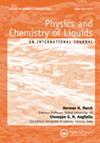甜菜碱染料33对(氯化胆碱:甘油)深共熔溶剂中锂盐的有效识别
IF 1.2
4区 化学
Q4 CHEMISTRY, PHYSICAL
引用次数: 0
摘要
深共晶溶剂(DESs)已成为普通溶剂和挥发性有机化合物的新替代品。它们作为电池电解质的应用一直是一个研究热点。在这种情况下,了解在锂盐存在下DESs的物理化学性质的变化变得至关重要。溶剂致变色探针有可能测量这种变化。本文报道了一种这样的紫外-可见分子吸光度探针Reichardt’s betaine dye 33,它可以有效地显示当盐LiCl加入时,由氢键接受盐氯化胆碱和氢键供体甘油按1:2摩尔比组成的DES甘氨酸发生的变化。当甘氨酸中加入3.0摩尔的LiCl时,该染料的分子内电荷转移吸光度带出现了17 nm的低色移。估计的ETN参数随LiCl摩尔分数呈线性增加。利用甜菜碱染料33、N、N-二乙基-4-硝基苯胺和4-硝基苯胺的光谱响应,评价了甘氨酸中双极性/极化率(π*)、供氢键酸度(α)和接受氢键碱度(β)的经验Kamlet-Taft参数与LiCl浓度的关系。在甘氨酸中加入LiCl导致α增加,而π*和β没有变化。提出了添加的锂与-OH官能团的氧相互作用,使溶剂的甘油生成具有更高的供氢键酸度。我们观察到,芘(一种常用的溶剂极性荧光探针)确实对向甘氨酸中加入LiCl有反应,然而,只有在LiCl浓度较高(mLiCl≥1.5 m)时,芘反应的变化才开始变得明显。在LiCl存在的情况下,Reichardt的甜菜碱染料在测量DESs的物理化学性质方面具有高度敏感性和多用途性。本文章由计算机程序翻译,如有差异,请以英文原文为准。
Effective Recognition of Lithium Salt in (Choline Chloride: Glycerol) Deep Eutectic Solvent by Reichardt’s Betaine Dye 33
Deep eutectic solvents (DESs) have emerged as novel alternatives to common solvents and VOCs. Their employment as electrolytes in batteries has been an area of intense research. In this context, understanding changes in the physicochemical properties of DESs in the presence of Li salts becomes of utmost importance. Solvatochromic probes have the potential to gauge such changes. It is reported herein that one such UV–vis molecular absorbance probe, Reichardt’s betaine dye 33, effectively manifests changes taking place in a DES Glyceline composed of H-bond accepting salt choline chloride and H-bond donor glycerol in a 1:2 molar ratio, as salt LiCl is added. The lowest energy intramolecular charge–transfer absorbance band of this dye exhibits a 17 nm hypsochromic shift as up to 3.0 molal LiCl is added to Glyceline. The estimated ETN parameter shows a linear increase with the LiCl mole fraction. Spectroscopic responses of betaine dye 33, N,N-diethyl-4-nitroaniline and 4-nitroaniline are used to assess empirical Kamlet–Taft parameters of dipolarity/polarizability (π*), H-bond-donating acidity (α) and H-bond-accepting basicity (β) as a function of LiCl concentration in Glyceline. LiCl addition to Glyceline results in an increase in α and no change in π* and β. It is proposed that the added lithium interacts with the oxygen of the –OH functionalities on the glycerol rendering of the solvent with increased H-bond-donating acidity. It is observed that pyrene, a popular fluorescence probe of solvent polarity, does respond to the addition of LiCl to Glyceline, however, the change in pyrene response starts to become noticeable only at higher LiCl concentrations (mLiCl ≥ 1.5 m). Reichardt’s betaine dye is found to be highly sensitive and versatile in gauging the physicochemical properties of DESs in the presence of LiCl.
求助全文
通过发布文献求助,成功后即可免费获取论文全文。
去求助
来源期刊

Physics and Chemistry of Liquids
化学-物理:凝聚态物理
CiteScore
3.30
自引率
8.30%
发文量
43
审稿时长
6-12 weeks
期刊介绍:
Physics and Chemistry of Liquids publishes experimental and theoretical papers, letters and reviews aimed at furthering the understanding of the liquid state. The coverage embraces the whole spectrum of liquids, from simple monatomic liquids and their mixtures, through charged liquids (e.g. ionic melts, liquid metals and their alloys, ions in aqueous solution, and metal-electrolyte systems) to molecular liquids of all kinds. It also covers quantum fluids and superfluids, such as Fermi and non-Fermi liquids, superconductors, Bose-Einstein condensates, correlated electron or spin assemblies.
By publishing papers on physical aspects of the liquid state as well as those with a mainly chemical focus, Physics and Chemistry of Liquids provides a medium for the publication of interdisciplinary papers on liquids serving its broad international readership of physicists and chemists.
 求助内容:
求助内容: 应助结果提醒方式:
应助结果提醒方式:


